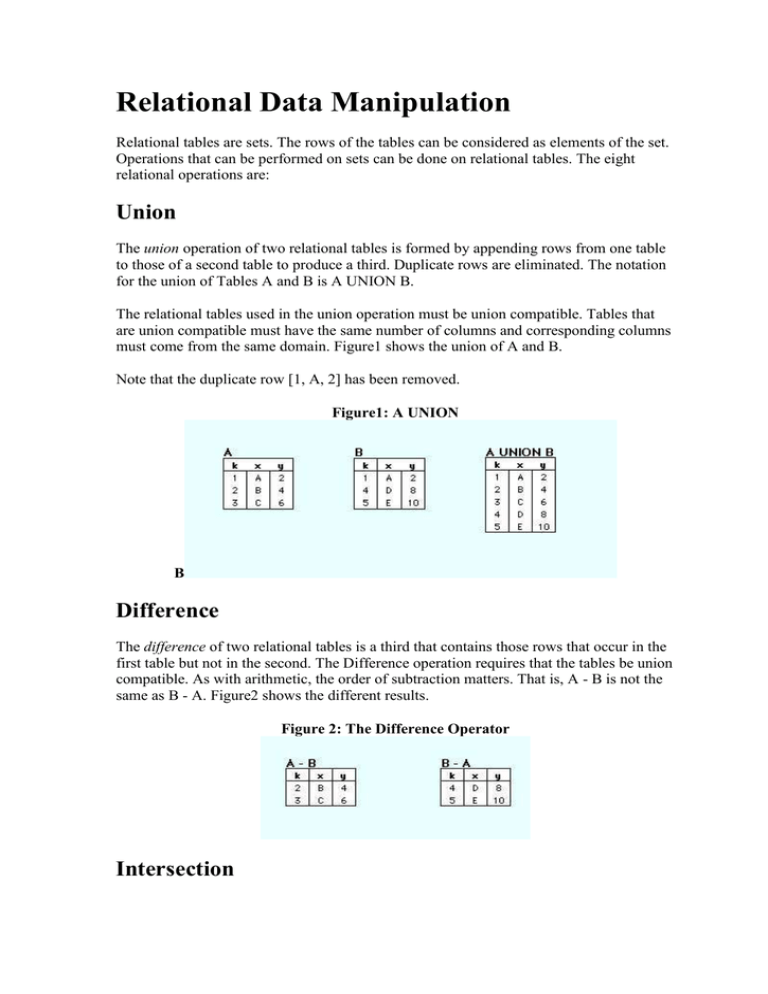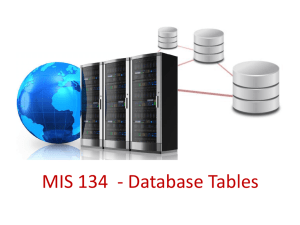Relational Data Manipulation
advertisement

Relational Data Manipulation Relational tables are sets. The rows of the tables can be considered as elements of the set. Operations that can be performed on sets can be done on relational tables. The eight relational operations are: Union The union operation of two relational tables is formed by appending rows from one table to those of a second table to produce a third. Duplicate rows are eliminated. The notation for the union of Tables A and B is A UNION B. The relational tables used in the union operation must be union compatible. Tables that are union compatible must have the same number of columns and corresponding columns must come from the same domain. Figure1 shows the union of A and B. Note that the duplicate row [1, A, 2] has been removed. Figure1: A UNION B Difference The difference of two relational tables is a third that contains those rows that occur in the first table but not in the second. The Difference operation requires that the tables be union compatible. As with arithmetic, the order of subtraction matters. That is, A - B is not the same as B - A. Figure2 shows the different results. Figure 2: The Difference Operator Intersection The intersection of two relational tables is a third table that contains common rows. Both tables must be union compatible. The notation for the intersection of A and B is A [intersection] B = C or A INTERSECT B. Figure3 shows the single row [1, A, 2] appears in both A and B. Figure3: Intersection Product The product of two relational tables, also called the Cartesian Product, is the concatenation of every row in one table with every row in the second. The product of table A (having m rows) and table B (having n rows) is the table C (having m x n rows). The product is denoted as A X B or A TIMES B. Figure 4: Product The product operation is by itself not very useful. However, it is often used as an intermediate process in a Join. Projection The project operator retrieves a subset of columns from a table, removing duplicate rows from the result. Selection The select operator, sometimes called restrict to prevent confusion with the SQL SELECT command, retrieves subsets of rows from a relational table based on a value(s) in a column or columns. Join A join operation combines the product, selection, and, possibly, projection. The join operator horizontally combines (concatenates) data from one row of a table with rows from another or the same table when certain criteria are met. The criteria involve a relationship among the columns in the join relational table. If the join criterion is based on equality of column value, the result is called an equijoin. A natural join is an equijoin with redundant columns removed. Figure 5 illustrates a join operation. Tables D and E are joined based on the equality of k in both tables. The first result is an equijoin. Note that there are two columns named k; the second result is a natural join with the redundant column removed. Figure 5: Join Joins can also be done on criteria other than equality. Division The division operator results in columns values in one table for which there are other matching column values corresponding to every row in another table. Figure 6: Division



